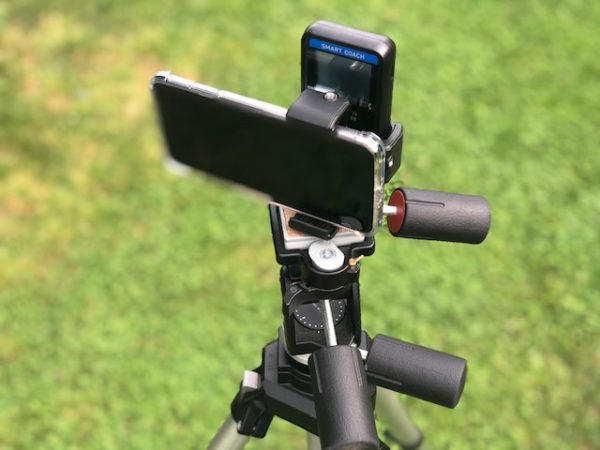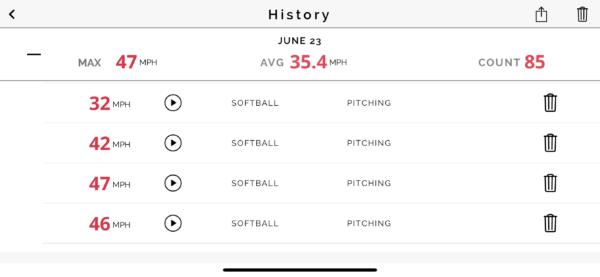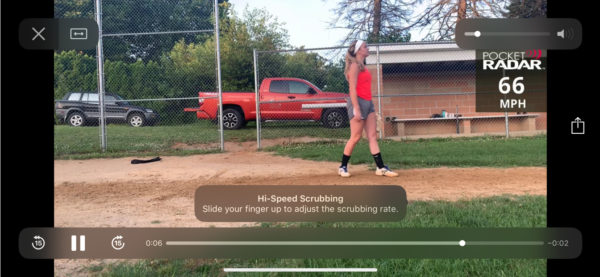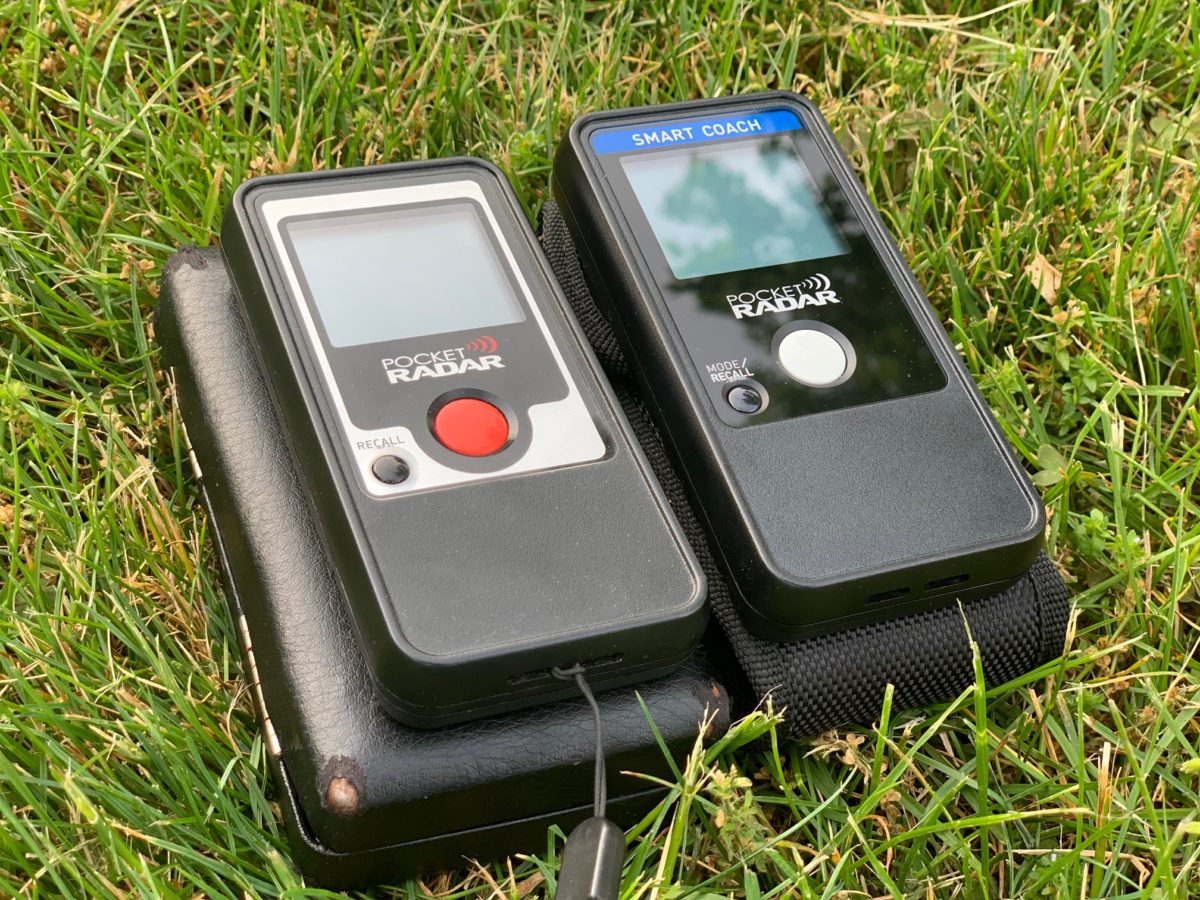Two significant changes in the newest Pocket Radar, called the Smart Coach Radar are:
- You can now power it with a 5 volt USB battery pack or plug it into an A/C wall outlet with a USB cube.
- It hooks up to an app, which records video and ties the video to the speed of pitch or exit velocity of a softball off a bat!
Having used the original red button Pocket Radar for years and frequently getting frustrated with trying to catch in one hand and time holding the red button down (while timing when the pitcher’s arm was in the 12 o’clock position) in the other it will come as no shock that I was ready to try something new. The red button Pocket Radar, for your information, turns out was never designed for tracking softball pitch or bat speed. It was designed for use by law enforcement to give a pocket-size device for use to check traffic speeds.
I put some time into a Smart Coach Pocket Radar review because I’ve spent a few months testing it out directly in my softball pitching and hitting lessons. There’s a lot of information and tips on different ways to use the device out there, but that is not the intent of this post. The intent of this post is to give a broad overview and to evaluate the product’s worthiness priced at $399, and base any recommendation off of my testing.

Smart Coach Radar Review
The Smart Coach Radar is the third in a series of Pocket Radar’s. The Ball Coach with the blue button was a bit better than the red button original Pocket Radar, but like I mentioned before, there are two significant advantages to the Smart Coach Radar that even the better blue-button radar didn’t have.
- The one advantage is you will no longer need to frequently change 2 AAA batteries or even rechargeable AAA(s), which typically would last at the most an hour if you utilized the constant-on setting. The Smart Coach with its new right angle USB attachment (sold separately) allows for the connection to have either a lipstick USB charger, which can last six hours in constant-on position, or then you can even plug the USB into a wall outlet through one of those white iPhone cubes that we’re likely all familiar with. As a softball coach or pitching and hitting instructor, you can spend less time and money changing batteries and more time analyzing and teaching using the device while tracking speeds in lessons.
- Example: benefit comparison of battery Life with Smart Coach ‘constant-on’ mode:
About 1 hour with 2 alkaline batteries
Maybe 2 hours with NiMH rechargeable batteries
Whopping 6-48 hours with a USB power pack!
- Example: benefit comparison of battery Life with Smart Coach ‘constant-on’ mode:
- The second advantage of the Smart Coach is the one that just seemingly blows the roof off of the potential for this radar gun, which will also tremendously distance itself from the radar competition… the app. As a coach, parent, or instructor you are now able to not only track and record speeds within the radar device, but now allows for video recording and viewing in the app while attaching the specific video to the specific speed, with history listing! Never before have I been able to as easily track speed increases or decreases and be able to visually relate that increase or decrease directly to mechanics of the athlete, in a high resolution, slow-motion speed-scrubbing video no less. The possibilities for me now as a pitching coach to teach girls about mechanical adjustments and how these adjustments impact velocity are unparalleled!
In my pitching lessons, I have already been able to help girls gain speed with this device. A 5′ 8″, 16-year-old girl that recently came to me with her fastball stuck in the mid-50s for the last few years is now throwing high-50s/low-60s because I made suggestions while comparing upper-half and lower-half timing adjustments in videos related to speed recordings from the radar. Now she visually understands, and understanding is at least half the battle.
The app also has audio features. When the audio setting is turned on in the app, and the volume turned up on the mobile phone, as the softball pitchers make adjustments, they get speed feedback, verbally, in real-time from the app. Then again, later, as we review the video recordings together, this speed is linked to a video of a pitch or hit. Never have I had a pitching aid of this magnitude before. It gives me the ability to be able to communicate speed history visually, which can have instant effect—in a single lesson! - Other advantages of the new Smart Coach Radar over previous versions are that it works with larger mobile displays, like an iPad or other tablet; has an auto-on function; remote control of radar device; audio speed callouts; speeds are embedded in video; and a dual-mode shows the speed display and video at same time. You can also export data to a CSV file for later study.
Why use radar on a softball pitcher anyway?
The change-up is arguably the most effective pitch in softball. It helps keep good hitters off-balance and off-power. One of the main reasons I use radar in the first place is to push the speed differential between the fastball (or curve, rise, screw, etc.) and the change-up, especially in younger pitchers that are just leaning the pitch. With the speed of the ball now tied to the video that shows mechanics in super slow-motion, which I can scrub with my finger. I can easily hone in on when a pitcher is slowing her mechanics down to slow the ball down, which is not recommended; smart hitters will pick up on any tendencies or changes in mechanics or delivery of one pitch to another. (i.e., the change-up’s mechanics should be no slower than the fastball’s, and this radar/app setup helps me teach this concept effectively.)

The radar app opens the door to a bright future
I’m excited about future versions of the app, which I wouldn’t be surprised to include:
- The ability to notate and draw angles, lines, squares, circles on a still of the athlete’s video, to visually indicate opportunity areas to female athletes as they pitch and hit.
- Currently, as of the writing of this post, the app only records in horizontal mode, which leaves the door open for future renditions of the app to take advantage of vertical modes, especially when a single instructor or catcher, or even a pitcher by herself is throwing into a net. This would help clarify when trying to see how improvements affect speed from a single tripod, either in front or behind her pitching motion. Vertical 9:16 aspect ratio could show more detail while much better using the resolution and space on the screen.
- The highest value I could see coming from future versions of the app though, would be a feature to be able to stack or show side-by-side 2 different videos recorded by the app. This would allow an instructor or student to compare more naturally any mechanical changes from one pitch to the next while relating again to the speed of mechanics, the arm, or the bat.
These are just a few of the enhancements I would enjoy as a pitching coach, and I would expect those in future updates of the app. The skies the limit really.
Review of the Pocket Radar app. How does the Smart Coach work?
From the moment you download the app from the app store to your mobile device, which can be your cell phone or a tablet, the user interface (UI) and the user experience (UX) is well designed and very friendly. It’s almost idiot-proof, but it will take a few times to really get the hang of the way 2 to 4 different gadgets (i.e., the phone, the radar device, the USB battery, and even an external display) interact for a single speed study. For example, if you have a separate screen like an iPad you will need to sync that through a cable to the Smart Coach Radar, and then you can sync a mobile phone, which will capture the video via Bluetooth.
Most users will keep it simple and just use the Pocket Radar when standing behind home plate during a game (for example), trying to get speeds of a pitcher’s ball in motion. This is easy enough. You just hold down the button or put it in constant mode and hang it on the fence. No more will you have to time a motion sequence correctly like you used to with the red button radar.
Other instances in which the setup will most likely be used will be in pitching sessions or hitting sessions when you’re using the phone to transmit the display of the speed and an audio callout of the speed, or even then track video of the mechanics that generate the speed for later review. In this instance, she will use the Pocket Radar and the mobile phone, which the speed readings can be started either by pressing the pocket radar button, can be started directly from the start button on the mobile phone app, or the radar device can auto-detect movement to start the video snippet and speed recording. Either way, if you put the Pocket Radar into the constant-on mode and use a USB charger, there’s very little room for error because it’s smart enough to know when to start the video and when to start the speed tracking based, again, on detecting motion.
For my testing, I used the Pocket Radar set up mostly for testing pitching speeds and looking at fastpitch softball mechanics for pitchers. Although this radar can also be used to quantify exit velocity speed off of a fastpitch softball bat, in cases where you want to test exit velocity off of a bat I recommend that you put a Bownet up and you put the Pocket Radar about 15 to 20 feet behind that, and then put the tee that you will be hitting off of about 15 to 20 feet in front of the net so ultimately the radar will be around 30 feet from the point of impact to record exit velocity speed off of the composite bat. Keep the launch angle of the ball as level as possible to get the best radar readouts. Note: The exit velocity must be greater than the bat swing speed for the radar to pick up the ball speed. This should always be the case for a well-hit ball.
With my testing of pitchers and hitters from 8 years old all the way up to 23 years old I find that using a large display (sold separately from Pocket Radar or you can use a tablet on a tripod) is a fun, and a rewarding way to keep the girls engaged. I find it also keeps them asking for the use of the device again, looking forward to their lessons more than usual. When my pitchers see the display showing large numbers indicating the speed after their pitch, they get the payoff of instant feedback of the speed reading immediately and almost becomes like a carnival game. And who doesn’t love carnival games? Except instead of the big teddy bear prize, she gets one step closer to securing the spot on her college roster (and maybe the scholarship that sometimes goes with it). Having a display giving instant feedback, whether it’s an iPad or the display that they sell at Pocket Radar, is a recommended component.

Does fastpitcher.com recommend the Smart Coach Radar?
Based on my testing of the Smart Coach Radar, I recommend it as an investment if you’re looking for highly accurate and highly informative speed tracking. The device, along with the app, adds an educational and rewarding element to workouts. The radar device is within +/- 1 MPH as accurate as any others you can buy, even the Stalker radar gun that cost around $1200. Being digital radar, though, I also feel more comfortable shooting it around kids. There is no other device on the market that I know of that can relate speed directly to video, with history tracking. The video playback allows for multiple levels of high-resolution, slow-mo scrubbing to really help study mechanical adjustments and their impact on speed. The app, along with the device, are very well designed and thought out. Not to mention, the customer service is very passionate and responsive, all the way up to the top (including Chris Stewart, their President who I collected data from for this post). Well done, Pocket Radar.

Smart Coach by Pocket Radar can be researched and purchased at www.pocketradar.com. I believe they have a trade-up program that gives you $100 off the Smart Coach if you have the red or blue button versions too.
If you have specific questions about this product or any of the strategies I discussed, then please feel free to leave them in the comment section below.

